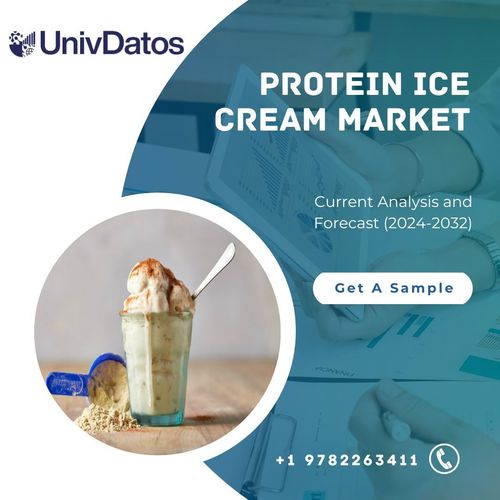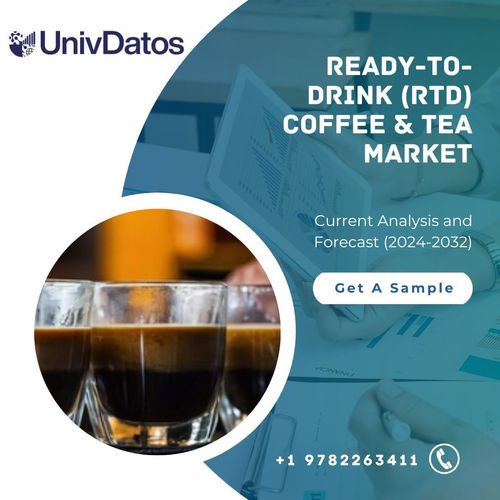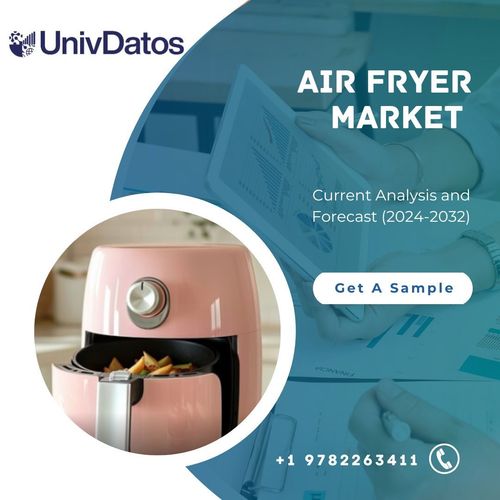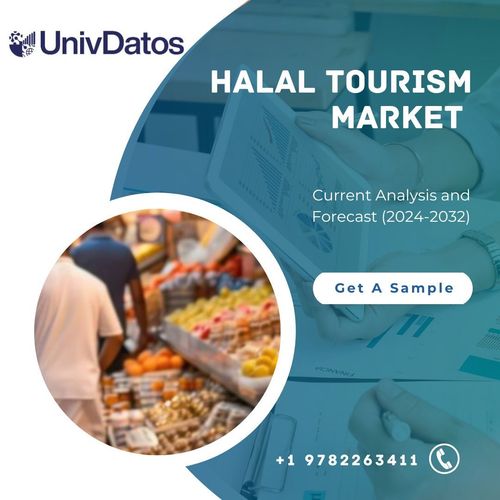Beverage Processing Equipment Market: Current Analysis and Forecast (2022-2028)
Emphasis on Equipment Type (Brewery, Filtration, Carbonation, Blenders & Mixtures, Heat Exchangers, and Others); Beverage Type (Carbonated, Non-Carbonated, Alcoholic, Dairy-Based, and Processed Water); and Region/Country
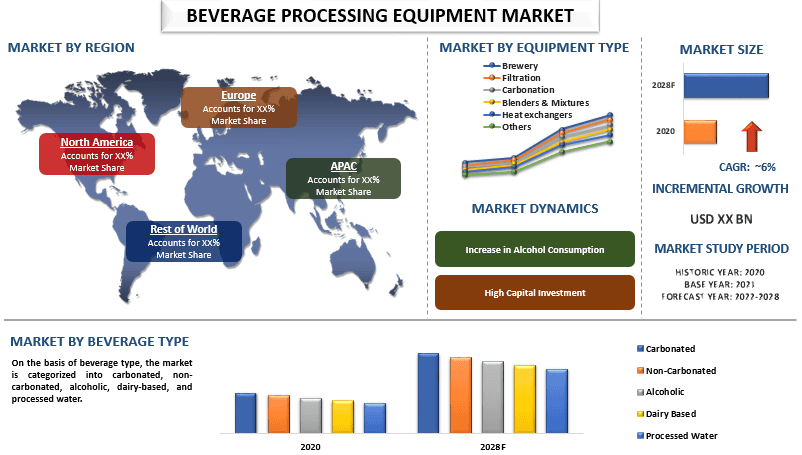
Global Beverage Processing Equipment Market is expected to grow at a significant rate of around 6% during the forecast period. Beverage processing equipment is used for the machines used to make a variety of beverages. It also means using physical and chemical equipment to transform raw ingredients into prepared food. In addition, they are used to process different types of drinks, also the production line usually includes numerous pieces of equipment, such as water treatment equipment, bottle washing machine, filler machines, sealing machines, sterilization equipment, CIP in-site cleaning devices, filtration equipment, and packaging machines, to name a few. Additionally, they are highly used in the production of dairy, bakery, poultry, seafood, beverage, and confectionery products.
Alfa Laval AB, GEA Group AG, Tetra Pak, Krones AG, Bucher Industries AG, SPX Flow Inc., JBT Corporation, Pentair plc, Praj Industries Ltd, KHS GmbH are some of the key players in the market. Several M&As along with partnerships have been undertaken by these players to facilitate customers with hi-tech and innovative products/technologies.
Insights Presented in the Report
“Amongst equipment type, brewery category is expected to witness the highest CAGR during the forecast period”
Based on equipment type, the market is segmented into brewery, filtration, carbonation, blenders & mixtures, heat exchangers, and others. The brewery category is expected to witness the highest CAGR during the forecast period owing to the growing consumption of beer globally. In addition, the increasing demand and popularity of craft beer in India have led to an increase in the number of microbreweries and smaller craft breweries to ramp up production. Furthermore, factors such as better beer quality and beer styles over thousands of years, the growing number of social venues serving beer in cities, and the introduction of canned beer are increasing the demand for brewery equipment globally.
“Amongst beverage type, the alcoholic beverage segment held a significant share in the market in 2020”
On the basis of beverage type, the market is categorized into carbonated, non-carbonated, alcoholic, dairy-based, and processed water. Among these, the alcoholic beverage segment held a significant share of the market in 2020. This is mainly due to the growing demand for alcoholic beverages in both developed and developing countries. Additionally, the growing demand is mainly due to innovation and development in the production of vodkas, bears, flavored spirits, and cocktails, evolving consumer lifestyles, drinking preferences, and a growing number of breweries and wineries around the world. In recent years, the requirement for premium and super-premium alcoholic beverages has grown significantly. Moreover, recent advances in honey-derived products tend to become viable options for creating innovative alcoholic beverages for customers and driving potential growth of the market.
“APAC held a significant share in the market”
APAC is anticipated to grow at a substantial CAGR during the forecast period. This is mainly due to rising disposable incomes, rapid urbanization, and growing economies such as India and China. Also, the number of food processing facilities in the region is anticipated to rise, and the supply and consumption of food and beverage processing equipment are anticipated to rise further within the region. In addition, the consumption of alcoholic and non-alcoholic beverages is rising quickly, therefore producers need highly adaptable and sustainable processes is escalating the demand in the market. Additionally, rising consumer preference for health drinks, dietary supplements, and others is anticipated to support the market expansion within the region. Many major players also emphasize using automation and technology. For instance, in Sep 2021, Quintus Technologies re-enters the food & beverage arena with the launch of new high-pressure processing (HPP) systems and customized service solutions.
Reasons to buy this report:
- The study includes market sizing and forecasting analysis validated by authenticated key industry experts.
- The report presents a quick review of overall industry performance at one glance.
- The report covers an in-depth analysis of prominent industry peers with a primary focus on key business financials, product portfolio, expansion strategies, and recent developments.
- Detailed examination of drivers, restraints, key trends, and opportunities prevailing in the industry.
- The study comprehensively covers the market across different segments.
- Deep dive regional level analysis of the industry.
Customization Options:
The global beverage processing equipment market can further be customized as per the requirement or any other market segment. Besides this, UMI understands that you may have your own business needs, hence feel free to connect with us to get a report that completely suits your requirements.
Table of Contents
Research Methodology for the Beverage Processing Equipment Market Analysis (2022-2028)
Analyzing the historical market, estimating the current market, and forecasting the future market of the global beverage processing equipment market were the three major steps undertaken to create and analyze the adoption of beverage processing equipment in major regions globally. Exhaustive secondary research was conducted to collect the historical market numbers and estimate the current market size. Secondly, to validate these insights, numerous findings and assumptions were taken into consideration. Moreover, exhaustive primary interviews were also conducted, with industry experts across the value chain of the global beverage processing equipment market. Post assumption and validation of market numbers through primary interviews, we employed a top-down/bottom-up approach to forecasting the complete market size. Thereafter, market breakdown and data triangulation methods were adopted to estimate and analyze the market size of segments and sub-segments of the industry pertains to. Detailed methodology is explained below:
Analysis of Historical Market Size
Step 1: In-Depth Study of Secondary Sources:
Detail secondary study was conducted to obtain the historical market size of the beverage processing equipment market through company internal sources such as annual reports & financial statements, performance presentations, press releases, etc., and external sources including journals, news & articles, government publications, competitor publications, sector reports, third-party database, and other credible publications.
Step 2: Market Segmentation:
After obtaining the historical market size of the beverage processing equipment market, we conducted a detailed secondary analysis to gather historical market insights and share for different segments & sub-segments for major regions. Major segments are included in the report as equipment type and beverage type. Further country-level analyses were conducted to evaluate the overall adoption of testing models in that region.
Step 3: Factor Analysis:
After acquiring the historical market size of different segments and sub-segments, we conducted a detailed factor analysis to estimate the current market size of the beverage processing equipment market. Further, we conducted factor analysis using dependent and independent variables such as various equipment types and beverage types of beverage processing equipment. A thorough analysis was conducted for demand and supply-side scenarios considering top partnerships, mergers and acquisitions, business expansion, and product launches in the beverage processing equipment market sector across the globe.
Current Market Size Estimate & Forecast
Current Market Sizing: Based on actionable insights from the above 3 steps, we arrived at the current market size, key players in the global beverage processing equipment market, and market shares of the segments. All the required percentage shares split, and market breakdowns were determined using the above-mentioned secondary approach and were verified through primary interviews.
Estimation & Forecasting: For market estimation and forecast, weights were assigned to different factors including drivers & trends, restraints, and opportunities available for the stakeholders. After analyzing these factors, relevant forecasting techniques i.e., the top-down/bottom-up approach were applied to arrive at the market forecast for 2028 for different segments and sub-segments across the major markets globally. The research methodology adopted to estimate the market size encompasses:
- The industry’s market size, in terms of revenue (USD) and the adoption rate of the beverage processing equipment market across the major markets domestically
- All percentage shares, splits, and breakdowns of market segments and sub-segments
- Key players in the global beverage processing equipment market in terms of products offered. Also, the growth strategies adopted by these players to compete in the fast-growing market
Market Size and Share Validation
Primary Research: In-depth interviews were conducted with the Key Opinion Leaders (KOLs) including Top Level Executives (CXO/VPs, Sales Head, Marketing Head, Operational Head, Regional Head, Country Head, etc.) across major regions. Primary research findings were then summarized, and statistical analysis was performed to prove the stated hypothesis. Inputs from primary research were consolidated with secondary findings, hence turning information into actionable insights.
Split of Primary Participants in Different Regions
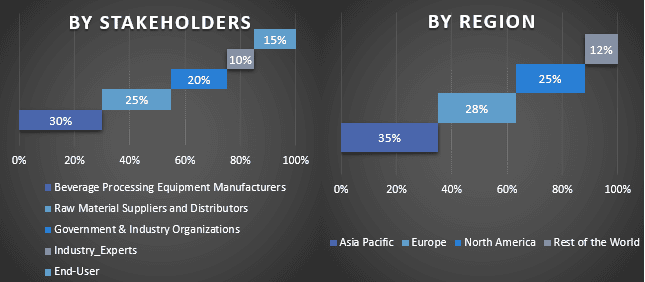
Market Engineering
The data triangulation technique was employed to complete the overall market estimation and to arrive at precise statistical numbers for each segment and sub-segment of the global beverage processing equipment market. Data was split into several segments & sub-segments post studying various parameters and trends in the areas of equipment type and beverage type in the global beverage processing equipment market.
The main objective of the Global Beverage Processing Equipment Market Study
The current & future market trends of the global beverage processing equipment market were pinpointed in the study. Investors can gain strategic insights to base their discretion for investments on the qualitative and quantitative analysis performed in the study. Current and future market trends determined the overall attractiveness of the market at a regional level, providing a platform for the industrial participant to exploit the untapped market to benefit from a first-mover advantage. Other quantitative goals of the studies include:
- Analyze the current and forecast market size of the beverage processing equipment market in terms of value (USD). Also, analyze the current and forecast market size of different segments and sub-segments
- Segments in the study include areas of equipment type and beverage type.
- Define and analysis of the regulatory framework for the beverage processing equipment
- Analyze the value chain involved with the presence of various intermediaries, along with analyzing customer and competitor behaviors of the industry.
- Analyze the current and forecast market size of the beverage processing equipment market for the major region.
- Major countries of regions studied in the report include Asia Pacific, Europe, North America, and the Rest of the World.
- Company profiles of the beverage processing equipment market and the growth strategies adopted by the market players to sustain in the fast-growing market
- Deep dive regional level analysis of the industry
Related Reports
Customers who bought this item also bought



